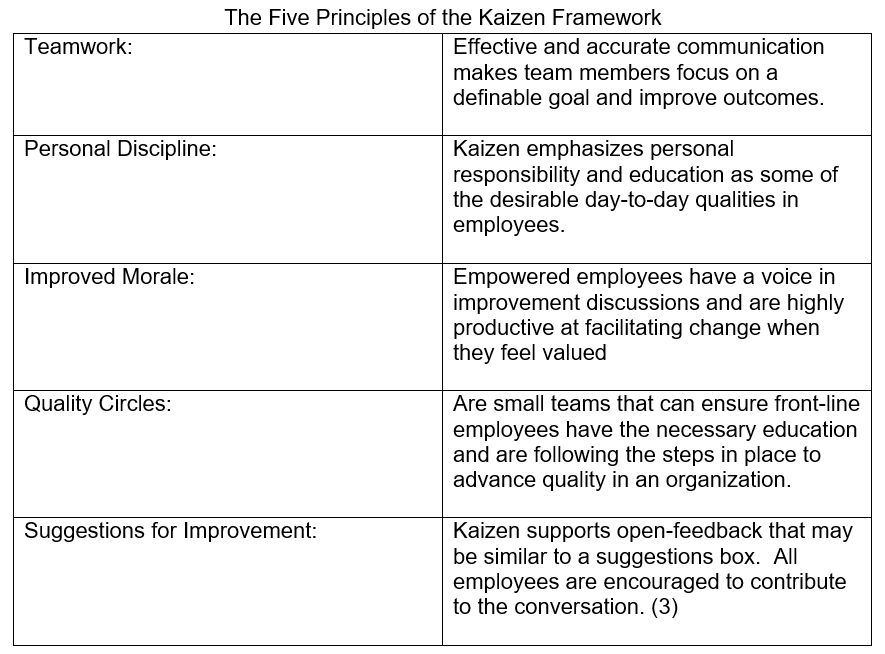Kaizen: Continuous Improvement
Dr. Jonathan Phillips
Previous blog posts have touched on reasons for Quality Improvement (QI) in healthcare as well as introductions to technical approaches such as Six Sigma that have been proven by industries to facilitate positive change. Technical approaches like Six Sigma rely on buy-in from upper management stakeholders as well as professionals with experience in statistics.
There are also opportunities for ground-level employees and stakeholders to participate in QI. Kaizen is a LEAN approach that focuses on “Continuous Improvement” in small daily changes which support larger institutional initiatives.
Change and Improvement
Kaizen comes from two words: kai “change” and zen “for better”. Dr. Berwick defined kaizen in the New England Journal of Medicine as “the continuous search for opportunities for all processes to get better”. (1) As part of an everyday culture of looking for improvement, it centers around small “kaizen events” which often last for 3-5 days and focuses on a single problem with a small group of people. These kaizen events should reduce waste, improve outcomes, boost morale, and bring sustainability. (2)
Kaizen Events
Kaizen events are the tools at the center of this approach. These need to answer very narrow and specific questions that support an organization's overall larger mission. One such large mission example would be: “Reducing a hospitalization length of stay (LOS)”. A kaizen event could then answer the specific question on how to speed up the delivery of medications to a patient’s room on the day of discharge to support the organization’s larger mission.
These kaizen events are short and intense 3-5 day events with small groups of on-the-ground-floor employees who are actively working in the area being studied.
Assemble a team comprised of both senior leadership and employees who engage in the daily operations
Clearly outline the current processes, their shortcomings, and a list of potential changes that could be made
From available solutions that were identified, determine which ones can be easily and quickly implemented to bring about identifiable change.
After implementation, measure the progress that was made in an objective way that can be presented to management and employees who worked on the project. (2)
A key difference between kaizen events and other methodologies (such as the PDSA cycle from the IHI Quality Method) is that kaizen events are short and focused on a single problem. These are meant to be repeated many times for various new problems until the larger organizational goal is achieved.
A case series of four separate emergency departments who had kaizen events showed that three of them had favorable outcomes in regards to department throughput and patient satisfaction scores. Most notably, the hospital that had the greatest involvement of both upper management and ground-level employees had the best improvements--in emergency department throughput, patient satisfaction, and also staff satisfaction. Positive results appeared to be correlated to the amount of staff involvement, which highlights the need for total organizational buy-in. (4)
Organizational Change
Kaizen is one additional tool to add to an organization who wants to use LEAN methods to improve their QI. Importantly, it can be a simple and inexpensive tool to train a large number of people to engage in continuous improvement through the organization.
Jonathan Phillips, D.O.
University of Louisville | Internal Medicine and Pediatrics
Dr. Jonathan Phillips is PGY-4 resident at the University of Louisville for Internal Medicine and Pediatrics. He attended Kentucky Wesleyan College for his undergrad and completed medical school at the Kanas City University of Medicine and Biosciences.
References
BERWICK D. Continuous Improvement as an Ideal in Health-Care. NEW ENGLAND JOURNAL OF MEDICINE. 1989;320(1):53-56. Accessed November 10, 2021. https://search-ebscohost-com.echo.louisville.edu/login.aspx?direct=true&db=edswsc&AN=A1989R576400010&site=eds-live
Villanova University. “Critical Factors That Determine the Success of Kaizen Events”. Updated October 14, 2010. Accessed November 14th, 2021. https://www.villanovau.com/resources/six-sigma/kaizen-event-steps/
Tetteh, H.A. (2012), Kaizen: A Process Improvement Model for the Business of Health Care and Perioperative Nursing Professionals. AORN Journal, 95: 104-108. https://doi-org.echo.louisville.edu/10.1016/j.aorn.2011.11.001
Dickson EW, Anguelov Z, Vetterick D, Eller A, Singh S. Use of Lean in the Emergency Department: A Case Series of 4 Hospitals. Annals of Emergency Medicine. 2009;54(4):504-510. doi:10.1016/j.annemergmed.2009.03.024





